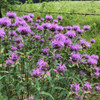Monarda menthifolia 'Apache' (M. fistulosa var. menthifolia 'Apache') - MINTLEAF BERGAMOT 'APACHE' (BEE BALM)
Produces a warm medium purple flowers and has dark stems and rich green leaves.
We believe this cultivar is very close to the natural form (or could even be), it is just vegetatively propagated. To prevent seeding, dead head the plant.
Monarda fistulosa var. menthifolia was considered an important medicinal plant for a very long time. The Tewa Native Americans cooked it with meat, and the Iroquois used the plant to make a beverage. An infusion made with bergamot was used as cough medicine and a kidney and heart aid. The plant was also made into a solution to cure sore eyes as well as a poultice for headaches, colds, cuts and burst boils. The root was chewed for swollen neck glands. Mintleaf Beebalm has analgesic, diuretic, diaphoretic and sedative effects.
The other full scientific name for this plant is Monarda fistulosa ssp. fistulosa var. menthifolia.
Shorter probably German cultivar that we brought over from Czech Republic.
Blooming Time: flowers after Monarda bradburiana and slightly before most of the common cultivars - about at the end May to mid June, right in the transition time from late spring to early summer
Size: a shorter bergamot, usually grows about 3' high x 2' wide. Spread moderately fast to fast into wide clumps, so leave some room for it
USDA Zones: 4 to 8
Culture: sun to half shade, grows well in most soils, including rocky soil or heavier soil; drought tolerant perennial
Moisture Needs: medium-dry, medium, medium-moist
Origin: native to most of the central-western states of USA: AZ, CO, IA, ID, MN, MT, ND, NE, NM, NV, SD, TX, UT, WA, WI, WY (and Canada). Naturally grows in upland woods, thickets, woodland edges.
Black Walnut tolerant: yes
Deer/Rabbit Resistant: yes, resistant to most herbivores
Attracts Butterflies or Pollinators: yes - true butterfly magnet - attracts flocks of the Great Spangled Fritillary, but also other butterflies and some native bees too
Pot Size: 3.5" x 4" perennial pot (1.22 pt/580 ml)
Plant combinations: Flower beds in sun, prairie gardens, naturalistic gardens, for naturalization, meadows, low maintenance planting, deer resistant plantings, or drier edges of rain gardens (or swales).
Due to it's drought tolerance it goes well with most common native and non-native perennials and grasses - both on the drier side or slightly moist (medium, medium-moist). Plant for the middle of the sunny bed.
Picture copyright: US Perennials

Monarda menthifolia 'Apache' (M. fistulosa var. menthifolia 'Apache') - MINTLEAF BERGAMOT 'APACHE' (BEE BALM)
Produces a warm medium purple flowers and has dark stems and rich green leaves.
We believe this cultivar is very close to the natural form (or could even be), it is just vegetatively propagated. To prevent seeding, dead head the plant.
Monarda fistulosa var. menthifolia was considered an important medicinal plant for a very long time. The Tewa Native Americans cooked it with meat, and the Iroquois used the plant to make a beverage. An infusion made with bergamot was used as cough medicine and a kidney and heart aid. The plant was also made into a solution to cure sore eyes as well as a poultice for headaches, colds, cuts and burst boils. The root was chewed for swollen neck glands. Mintleaf Beebalm has analgesic, diuretic, diaphoretic and sedative effects.
The other full scientific name for this plant is Monarda fistulosa ssp. fistulosa var. menthifolia.
Shorter probably German cultivar that we brought over from Czech Republic.
Blooming Time: flowers after Monarda bradburiana and slightly before most of the common cultivars - about at the end May to mid June, right in the transition time from late spring to early summer
Size: a shorter bergamot, usually grows about 3' high x 2' wide. Spread moderately fast to fast into wide clumps, so leave some room for it
USDA Zones: 4 to 8
Culture: sun to half shade, grows well in most soils, including rocky soil or heavier soil; drought tolerant perennial
Moisture Needs: medium-dry, medium, medium-moist
Origin: native to most of the central-western states of USA: AZ, CO, IA, ID, MN, MT, ND, NE, NM, NV, SD, TX, UT, WA, WI, WY (and Canada). Naturally grows in upland woods, thickets, woodland edges.
Black Walnut tolerant: yes
Deer/Rabbit Resistant: yes, resistant to most herbivores
Attracts Butterflies or Pollinators: yes - true butterfly magnet - attracts flocks of the Great Spangled Fritillary, but also other butterflies and some native bees too
Pot Size: 3.5" x 4" perennial pot (1.22 pt/580 ml)
Plant combinations: Flower beds in sun, prairie gardens, naturalistic gardens, for naturalization, meadows, low maintenance planting, deer resistant plantings, or drier edges of rain gardens (or swales).
Due to it's drought tolerance it goes well with most common native and non-native perennials and grasses - both on the drier side or slightly moist (medium, medium-moist). Plant for the middle of the sunny bed.
Picture copyright: US Perennials




